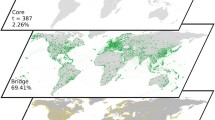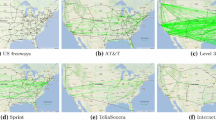Abstract
This paper shows how module identification techniques can help airports evaluate the impact of new routes on their network connectivity. Although only carriers can choose whether to open a new route, this research is also of interest to airports and regional governments, who can offer incentives for new connections to desirable destinations. The analysis employs simulated annealing to verify the existence of highly interconnected subsystems, or modules, within the European aviation network. A module is a group of airports with very strong internal links in terms of exchanged seats, but weak connections to the rest of the network. From the standpoint of improving connectivity, we expect that new routes towards large airports belonging to other modules are the most desirable. We also find that the lower the interchange between the modules to be connected, the higher the connectivity gain. We test this hypothesis on all 467 European airports with at least one scheduled flight in autumn 2007.

Similar content being viewed by others
Notes
For example, the new “Shop Route” service by Anna.aero (www.therouteshop.com).
The HHI is defined as \( \sum\limits_{i = 1}^n {{s_i}^2} \), where S i is the share of connections offered by single airports in the first case (HHI per airports) or airports in the module grouped by countries of reference in the second case (HHI per country).
One may think that these empirical results are a direct consequence of the way in which module identification was carried out. Although simulated annealing considers only direct links between airports to identify modules, however at this stage we are employing a broader measure of airport accessibility that includes indirect connections.
The number 1.41 is the constant term 1.247 plus the SizeDest coefficient, 2.04E−5 multiplied by the average number of daily offered seats among arrival airports, 8,165. Since the arrival airport is assumed to belong to an unrelated module, the percentage Interchange is set to zero.
In this case, the maximum number of seats offered daily is 135,227. Thus, 1.247+2.04E-5*135,227 = 4.
References
Air Transport Research Society (2007) Global airport benchmarking report: global standards for airport excellence. Vancouver, Canada, Various Issues.
Bagler G (2004) Analysis of the airport network of India as a complex weighted network. arXiv:cond-mat/0409773.
Bootsma PD (1997) Airline flight schedule development; analysis and design tools for European hinterland hubs. Dissertation, Utrecht, University of Twente
Burghouwt G (2007) Airline network development in Europe and its implications for airport planning. Ashgate, Aldershot
Burghouwt G, de Wit J (2005) The temporal configuration of airline networks in Europe. J Air Transp Manag 11(3):185–198
Burghouwt G, Redondi R (2009) Connectivity in air transport networks: models, measures and applications, Working paper, Department of Economics and Technology Management, University of Bergamo, Italy, no. 1/09
Burghouwt G, Veldhuis J (2006) The competitive position of hub airports in the Transatlantic market. J Air Transp 11(1):1071–30
Cronrath E, Arndt A, Zoch A (2008) Does size matter? The importance of airports in the European and German air transport network. Air Transport Research Society Conference, June 2008, Athens
Dennis NP (1994) Scheduling strategies for airline hub operations. J Air Transp Manag 1(2):131–144
Dennis NP (1998) Competition between Hub Airports in Europe and a methodology for forecasting connecting traffic. 8th World Conference on Transport Research, Antwerp
EC European commission (2005) Community guidelines on financing of airports and start-up aid to airlines departing from regional airports, Official Journal of the European Union, 2005/C 312/1
Fortunato S, Barthélemy M (2007) Resolution limit in community detection. PNAS Proc Nat Acad Sci USA 104(1):36–41
Graham A (2005) Airport Benchmarking: a review of the current situation. Benchmark Int J 12(2):99–111
Guida M, Funaro M (2007) Topology of the Italian airport network: a scale-free small-world network with a fractal structure? Chaos, Solitons Fractals 31:527–536
Guimerà R, Amaral LAN (2005) Functional cartography of complex metabolic networks. Nature 433:895–900
Guimerà R, Mossa S, Turtschi A, Amaral L (2005) The worldwide air transportation network: anomalous centrality, community structure, and cities’ global roles. PNAS Proc Nat Acad Sci USA 102(22):7794–7799
Guimerà R, Sales-Pardo M, Amaral LAN (2007) Classes of complex networks defined by role-to-role connectivity profiles. Nat Phys 3:63–39
IATA International Air Transport Association (2000) Global airport connectivity monitor. IATA, Geneva
Kinkaid I, Tretheway M (2006) Guidelines for Benchmarking Airports. Working Paper, German Aviation Research Society
Kirkpatrick S, Gelatt CD, Vecchi MP (1983) Optimization by simulated annealing. Science 220:671–680
Li W, Cai X (2004) Statistical analysis of airport network of China. Phys Rev E 69(046106):1–6
Malighetti P, Paleari S, Redondi R (2008a) Connectivity of the European airport network: “self-help hubbing” and business implications. J Air Transp Manag 14(2):53–65
Malighetti, P, Gianmaria M, Paleari S, Redondi R (2008b) The Efficiency of European airports: do the importance in the EU network and the intensity of competition matter? The 6th Annual International Industrial Organization Conference, Washington
Martin J, Roman C (2006) A benchmarking analysis of Spanish commercial airports. A comparison between SMOP and DEA ranking methods. Netw Spat Econ 6:111–134
Newman MEJ, Girvan M (2004) Finding and evaluating community structure in networks. Phys Rev E 69:026113
O’Kelly ME (2010) Routing traffic at hub facilities. Netw Spat Econ. doi:10.1007/s11067-008-9061-z
Oum TH, Yu C (2004) Measuring airports’ operating efficiency: a summary of the ATRS global airport benchmarking report. Transport Res E Logist Transport Rev 40:515–532
Schintler LA, Kulkarni R, Gorman S, Roger S (2007) Using raster-based GIS and graph theory to analyze complex networks. Netw Spat Econ 7:301–313
Shaw SL, Ivy RJ (1994) Airline mergers and their effects on network structure. J Transp Geogr 2(4):234–246
Veldhuis J (1997) The competitive position of airline networks. J Air Transp Manag 3(4):181–188
Xie F, Levison D (2009) Modeling the growth of transportation networks: a comprehensive review. Netw Spat Econ 9:291–307
Acknowledgements
We wish to thank participants at the AiIG 2007 conference in Milan, the Airneth 2008 workshop in the Hague, and the ATRS 2009 conference held in Abu Dhabi for their useful comments and ideas. In particular, we are grateful to Ken Button for his comments. The authors remain responsible for any remaining errors and inaccuracies.
Author information
Authors and Affiliations
Corresponding author
Rights and permissions
About this article
Cite this article
Redondi, R., Malighetti, P. & Paleari, S. New Routes and Airport Connectivity. Netw Spat Econ 11, 713–725 (2011). https://doi.org/10.1007/s11067-010-9131-x
Published:
Issue Date:
DOI: https://doi.org/10.1007/s11067-010-9131-x




